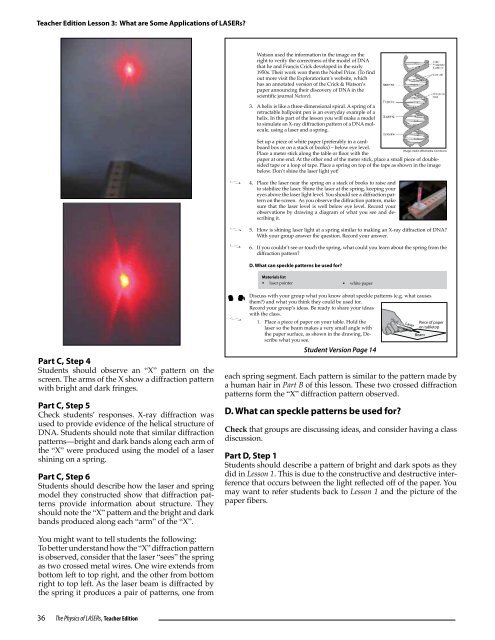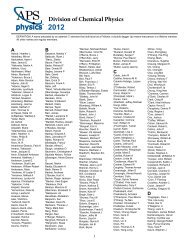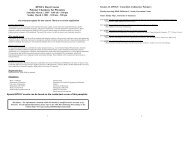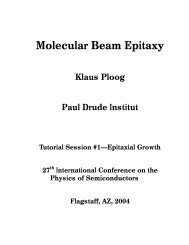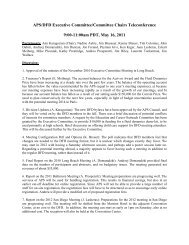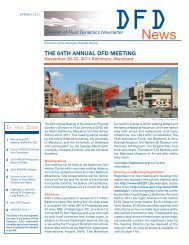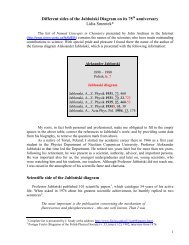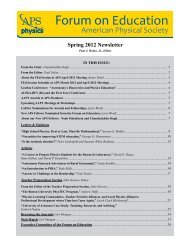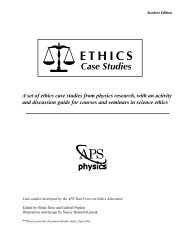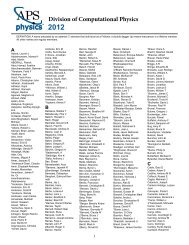The Physics of LASERs - American Physical Society
The Physics of LASERs - American Physical Society
The Physics of LASERs - American Physical Society
You also want an ePaper? Increase the reach of your titles
YUMPU automatically turns print PDFs into web optimized ePapers that Google loves.
Teacher Edition Lesson 3: What are Some Applications <strong>of</strong> <strong>LASERs</strong>?<br />
Part C, Step 4<br />
Students should observe an “X” pattern on the<br />
screen. <strong>The</strong> arms <strong>of</strong> the X show a diffraction pattern<br />
with bright and dark fringes.<br />
Part C, Step 5<br />
Check students’ responses. X-ray diffraction was<br />
used to provide evidence <strong>of</strong> the helical structure <strong>of</strong><br />
DNA. Students should note that similar diffraction<br />
patterns—bright and dark bands along each arm <strong>of</strong><br />
the “X” were produced using the model <strong>of</strong> a laser<br />
shining on a spring.<br />
Part C, Step 6<br />
Students should describe how the laser and spring<br />
model they constructed show that diffraction patterns<br />
provide information about structure. <strong>The</strong>y<br />
should note the “X” pattern and the bright and dark<br />
bands produced along each “arm” <strong>of</strong> the “X”.<br />
You might want to tell students the following:<br />
To better understand how the “X” diffraction pattern<br />
is observed, consider that the laser “sees” the spring<br />
as two crossed metal wires. One wire extends from<br />
bottom left to top right, and the other from bottom<br />
right to top left. As the laser beam is diffracted by<br />
the spring it produces a pair <strong>of</strong> patterns, one from<br />
36<br />
<strong>The</strong> <strong>Physics</strong> <strong>of</strong> <strong>LASERs</strong>, Teacher Edition<br />
Watson used the information in the image on the<br />
right to verify the correctness <strong>of</strong> the model <strong>of</strong> DNA<br />
that he and Francis Crick developed in the early<br />
1950s. <strong>The</strong>ir work won them the Nobel Prize. (To find<br />
out more visit the Exploratorium’s website, which<br />
has an annotated version <strong>of</strong> the Crick & Watson’s<br />
paper announcing their discovery <strong>of</strong> DNA in the<br />
scientific journal Nature).<br />
3. A helix is like a three-dimensional spiral. A spring <strong>of</strong> a<br />
retractable ballpoint pen is an everyday example <strong>of</strong> a<br />
helix. In this part <strong>of</strong> the lesson you will make a model<br />
to simulate an X-ray diffraction pattern <strong>of</strong> a DNA molecule,<br />
using a laser and a spring.<br />
Student Edition Lesson 3: What are Some Applications <strong>of</strong> LASERS?<br />
Set up a piece <strong>of</strong> white paper (preferably in a cardboard<br />
box or on a stack <strong>of</strong> books) – below eye level.<br />
Place a meter stick along the table or floor with the<br />
paper at one end. At the other end <strong>of</strong> the meter stick, place a small piece <strong>of</strong> doublesided<br />
tape or a loop <strong>of</strong> tape. Place a spring on top <strong>of</strong> the tape as shown in the image<br />
below. Don’t shine the laser light yet!<br />
4. Place the laser near the spring on a stack <strong>of</strong> books to raise and<br />
to stabilize the laser. Shine the laser at the spring, keeping your<br />
eyes above the laser light level. You should see a diffraction pattern<br />
on the screen. As you observe the diffraction pattern, make<br />
sure that the laser level is well below eye level. Record your<br />
observations by drawing a diagram <strong>of</strong> what you see and describing<br />
it.<br />
5. How is shining laser light at a spring similar to making an X-ray diffraction <strong>of</strong> DNA?<br />
With your group answer the question. Record your answer.<br />
6. If you couldn’t see or touch the spring, what could you learn about the spring from the<br />
diffraction pattern?<br />
D. What can speckle patterns be used for?<br />
Materials list<br />
• laser pointer • white paper<br />
Discuss with your group what you know about speckle patterns (e.g. what causes<br />
them?) and what you think they could be used for.<br />
Record your group’s ideas. Be ready to share your ideas<br />
with the class.<br />
1. Place a piece <strong>of</strong> paper on your table. Hold the<br />
laser so the beam makes a very small angle with<br />
the paper surface, as shown in the drawing. Describe<br />
what you see.<br />
Student Version Page 14<br />
each spring segment. Each pattern is similar to the pattern made by<br />
a human hair in Part B <strong>of</strong> this lesson. <strong>The</strong>se two crossed diffraction<br />
patterns form the “X” diffraction pattern observed.<br />
D. What can speckle patterns be used for?<br />
Image credit: Wikimedia Commons<br />
<strong>The</strong> <strong>Physics</strong> <strong>of</strong> <strong>LASERs</strong><br />
Check that groups are discussing ideas, and consider having a class<br />
discussion.<br />
Part D, Step 1<br />
Students should describe a pattern <strong>of</strong> bright and dark spots as they<br />
did in Lesson 1. This is due to the constructive and destructive interference<br />
that occurs between the light reflected <strong>of</strong>f <strong>of</strong> the paper. You<br />
may want to refer students back to Lesson 1 and the picture <strong>of</strong> the<br />
paper fibers.<br />
15


